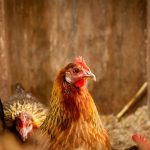Raising turkeys and chickens together presents several challenges for farmers and backyard poultry keepers. While both species are valued for their meat and egg production, they have distinct requirements and behavioral patterns that can complicate cohabitation. Turkeys, being significantly larger and more aggressive than chickens, may pose a physical threat to their smaller counterparts.
Furthermore, turkeys are more vulnerable to certain diseases that chickens can carry asymptomatically, potentially leading to the transmission of illnesses and subsequent losses in both flocks. To successfully manage a mixed flock, poultry keepers must be aware of these risks and implement appropriate measures to safeguard the health and well-being of both turkeys and chickens.
Table of Contents
- 1 Understanding the risks of mixing turkeys and chickens
- 2 Creating separate living spaces for turkeys and chickens
- 3 Implementing barriers to keep turkeys away from chickens
- 4 Providing separate feeding and watering stations
- 5 Monitoring and managing interactions between turkeys and chickens
- 6 Seeking professional advice and support
- 7 FAQs
- 7.1 What are the reasons to keep turkeys away from chickens?
- 7.2 How can turkeys transmit diseases to chickens?
- 7.3 What are some methods to keep turkeys away from chickens?
- 7.4 Are there any benefits to keeping turkeys and chickens together?
- 7.5 What are the signs of aggression between turkeys and chickens?
Key Takeaways
- Mixing turkeys and chickens can pose health risks for both species
- Turkeys can carry diseases that are harmless to them but deadly to chickens
- Separate living spaces for turkeys and chickens can prevent disease transmission
- Barriers such as fences and netting can help keep turkeys away from chickens
- Providing separate feeding and watering stations can reduce competition and aggression between turkeys and chickens
- Regular monitoring and management of interactions between turkeys and chickens is essential
- Seeking professional advice and support from a veterinarian or poultry expert is recommended
Understanding the risks of mixing turkeys and chickens
Risks of Disease Transmission
Turkeys are known to be carriers of blackhead disease, which is caused by a microscopic parasite called Histomonas meleagridis. While turkeys are more susceptible to the disease, chickens can carry the parasite without showing symptoms. If a turkey becomes infected, it can spread the disease to other turkeys and chickens in the flock.
Behavioral Conflicts and Resource Competition
Additionally, turkeys are larger and more aggressive than chickens, which can lead to bullying and pecking injuries. Turkeys may also compete with chickens for food and water, leading to stress and reduced productivity in both flocks.
Different Housing and Dietary Needs
Understanding these risks is crucial for implementing effective strategies to manage the cohabitation of turkeys and chickens. Turkeys need more space than chickens, as they are larger birds and require more room to move around comfortably. They also have different roosting habits, with turkeys preferring to roost higher off the ground than chickens. Furthermore, turkeys have different dietary needs than chickens, requiring higher levels of protein in their feed. Mixing turkeys and chickens in the same living space can lead to competition for food and potential malnutrition for one or both flocks.
Creating separate living spaces for turkeys and chickens

One of the most effective ways to manage the cohabitation of turkeys and chickens is to create separate living spaces for each flock. This can be achieved by building separate coops or housing areas for turkeys and chickens, ensuring that each flock has its own space to roost, nest, and move around comfortably. When designing the living spaces, it is important to consider the specific needs of each species, such as roosting preferences, space requirements, and ventilation.
Providing separate living spaces not only reduces the risk of aggression and bullying between turkeys and chickens but also helps prevent the spread of diseases that may affect one species more than the other. In addition to separate coops, it is important to provide separate outdoor areas for turkeys and chickens to roam and forage. This can be achieved by using fencing or netting to divide the outdoor space into separate enclosures for each flock.
Providing ample space for both turkeys and chickens to roam freely can help reduce stress and aggression between the two species. It also allows each flock to access their own food and water sources without competition from the other species. Creating separate living spaces for turkeys and chickens is a proactive measure that can help ensure the health and well-being of both flocks.
Implementing barriers to keep turkeys away from chickens
In addition to creating separate living spaces, implementing barriers can help keep turkeys away from chickens and reduce the risk of aggression and disease transmission. Barriers can include physical structures such as fencing, netting, or walls that prevent direct contact between turkeys and chickens. These barriers should be tall enough to prevent turkeys from flying over or reaching through to access the other flock.
Additionally, barriers can be used to create separate feeding and watering stations for turkeys and chickens, further reducing competition and potential conflict between the two species. Another effective barrier is the use of visual barriers, such as plants or shrubs, that create a visual barrier between turkeys and chickens without completely blocking airflow or sunlight. This can help reduce stress and aggression between the two species while still allowing them to cohabitate in close proximity.
Implementing barriers is an important step in managing the interactions between turkeys and chickens and can help prevent potential conflicts and disease transmission.
Providing separate feeding and watering stations
Providing separate feeding and watering stations for turkeys and chickens is essential for reducing competition and potential conflict between the two species. Turkeys have different dietary needs than chickens, requiring higher levels of protein in their feed. Providing separate feeding stations ensures that each flock has access to the appropriate feed without competition from the other species.
This can help prevent malnutrition in one or both flocks and reduce stress and aggression between turkeys and chickens. In addition to separate feeding stations, it is important to provide separate watering stations for turkeys and chickens. Turkeys require more water than chickens due to their larger size, so it is important to ensure that they have access to an ample water supply without competition from the smaller birds.
Providing separate watering stations also reduces the risk of disease transmission through shared water sources. By providing separate feeding and watering stations, poultry farmers and backyard enthusiasts can help ensure the health and well-being of both turkeys and chickens.
Monitoring and managing interactions between turkeys and chickens

Early Identification of Potential Conflicts
Regular observation of the flocks is crucial for identifying any potential conflicts or signs of illness early on, allowing for proactive intervention. It is essential to watch for any aggressive behavior from turkeys towards chickens, as well as signs of stress or malnutrition in either flock.
Proactive Measures to Prevent Conflicts
By monitoring interactions between turkeys and chickens, poultry farmers and backyard enthusiasts can take proactive measures to prevent potential conflicts and ensure the health of both flocks. In addition to monitoring interactions, it is important to manage the flocks in a way that reduces stress and aggression between turkeys and chickens.
Reducing Stress and Aggression
This can be achieved by providing ample space for both flocks to roam freely, as well as ensuring that each flock has access to their own food and water sources without competition from the other species. By taking these measures, poultry farmers and backyard enthusiasts can reduce the risk of aggression, bullying, and disease transmission between turkeys and chickens.
Seeking professional advice and support
Finally, seeking professional advice and support from poultry experts or veterinarians can provide valuable guidance for managing the cohabitation of turkeys and chickens. These professionals can offer insights into best practices for housing, feeding, and managing interactions between the two species. They can also provide guidance on disease prevention and treatment, as well as proactive measures for reducing stress and aggression between turkeys and chickens.
In addition to professional advice, joining poultry associations or online forums can provide a valuable support network for poultry farmers and backyard enthusiasts. These communities offer opportunities to connect with others who have experience raising turkeys and chickens together, as well as access to resources and information on best practices for managing interactions between the two species. Seeking professional advice and support is an important step in ensuring the health and well-being of both turkeys and chickens on a farm or in a backyard setting.
In conclusion, raising turkeys and chickens together can be a challenging endeavor due to their different needs, behaviors, and risks of disease transmission. Understanding these risks is crucial for implementing effective strategies to manage their cohabitation. Creating separate living spaces, implementing barriers, providing separate feeding and watering stations, monitoring interactions, and seeking professional advice are all important steps in ensuring the health and well-being of both flocks.
By taking proactive measures to manage interactions between turkeys and chickens, poultry farmers and backyard enthusiasts can create a harmonious environment where both species can thrive.
If you’re looking for ways to keep turkeys away from your chickens, you might find this article on chicken coop design in Muskegon helpful. It offers tips on how to create a secure and predator-proof coop that can help keep turkeys and other potential threats at bay. Check it out here.
FAQs
What are the reasons to keep turkeys away from chickens?
Turkeys can be carriers of diseases that are harmful to chickens, and they may also be aggressive towards chickens, leading to injuries or stress.
How can turkeys transmit diseases to chickens?
Turkeys can carry diseases such as blackhead, which is caused by a parasite that can be fatal to chickens. They can also spread other bacterial and viral diseases through direct contact or shared living spaces.
What are some methods to keep turkeys away from chickens?
Some methods include keeping turkeys and chickens in separate enclosures, using physical barriers such as fences or netting, and providing separate feeding and watering areas for each species.
Are there any benefits to keeping turkeys and chickens together?
While some people may keep turkeys and chickens together without issues, it is generally recommended to keep them separate to minimize the risk of disease transmission and aggression.
What are the signs of aggression between turkeys and chickens?
Signs of aggression may include pecking, chasing, or fighting between the two species. It’s important to monitor their behavior and separate them if necessary to prevent injuries.
Meet Walter, the feathered-friend fanatic of Florida! Nestled in the sunshine state, Walter struts through life with his feathered companions, clucking his way to happiness. With a coop that’s fancier than a five-star hotel, he’s the Don Juan of the chicken world. When he’s not teaching his hens to do the cha-cha, you’ll find him in a heated debate with his prized rooster, Sir Clucks-a-Lot. Walter’s poultry passion is no yolk; he’s the sunny-side-up guy you never knew you needed in your flock of friends!







